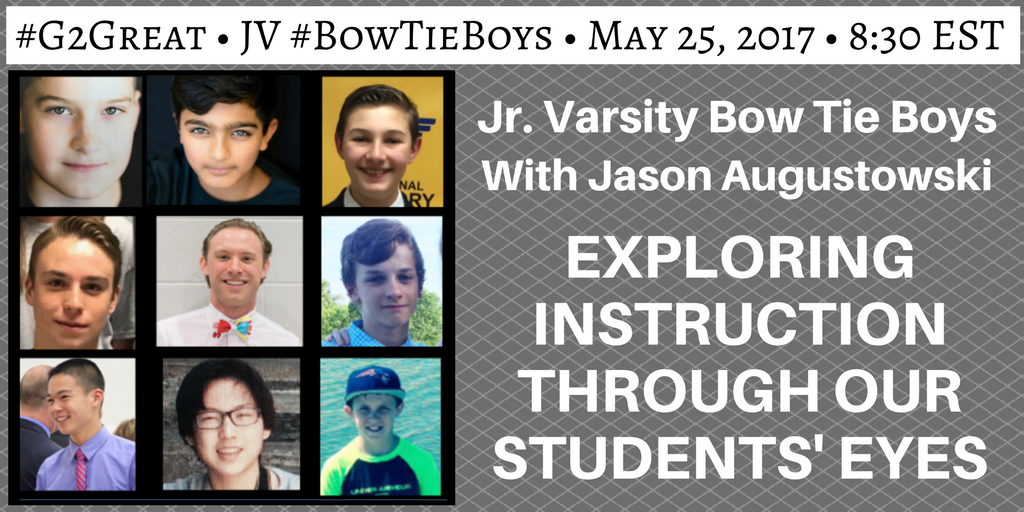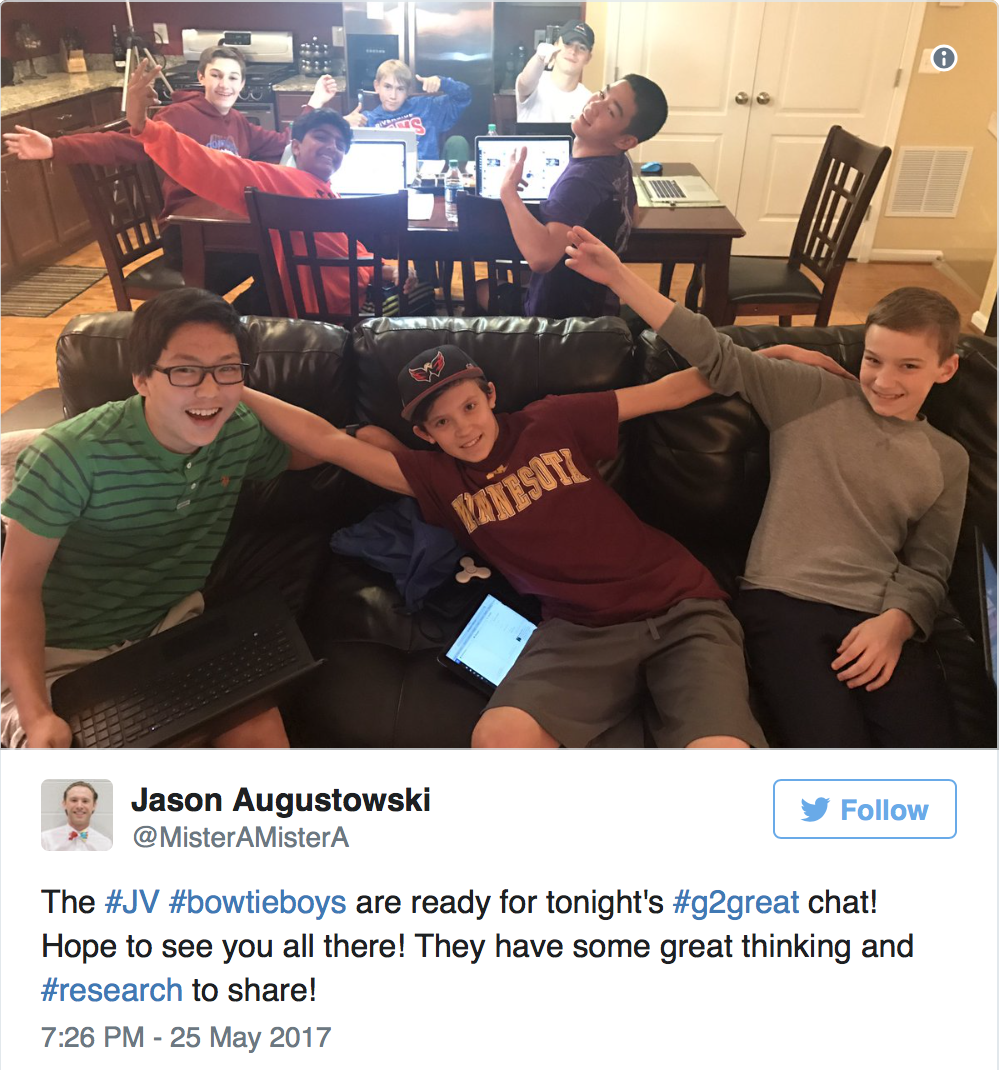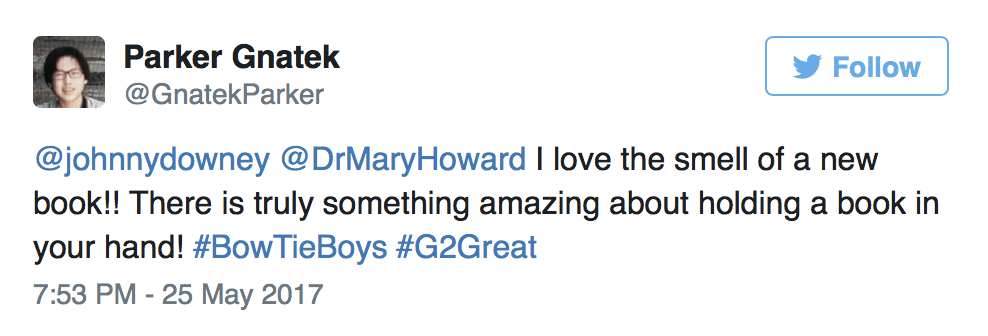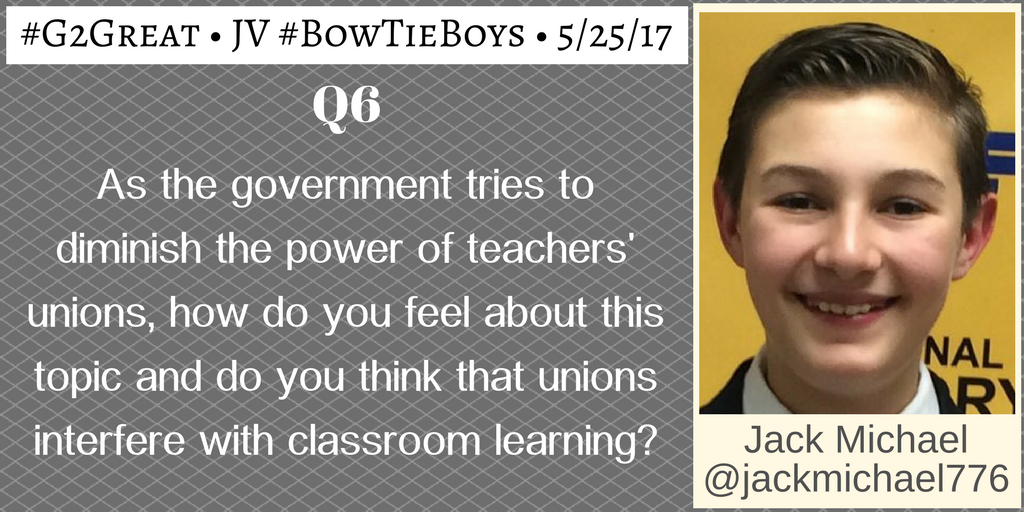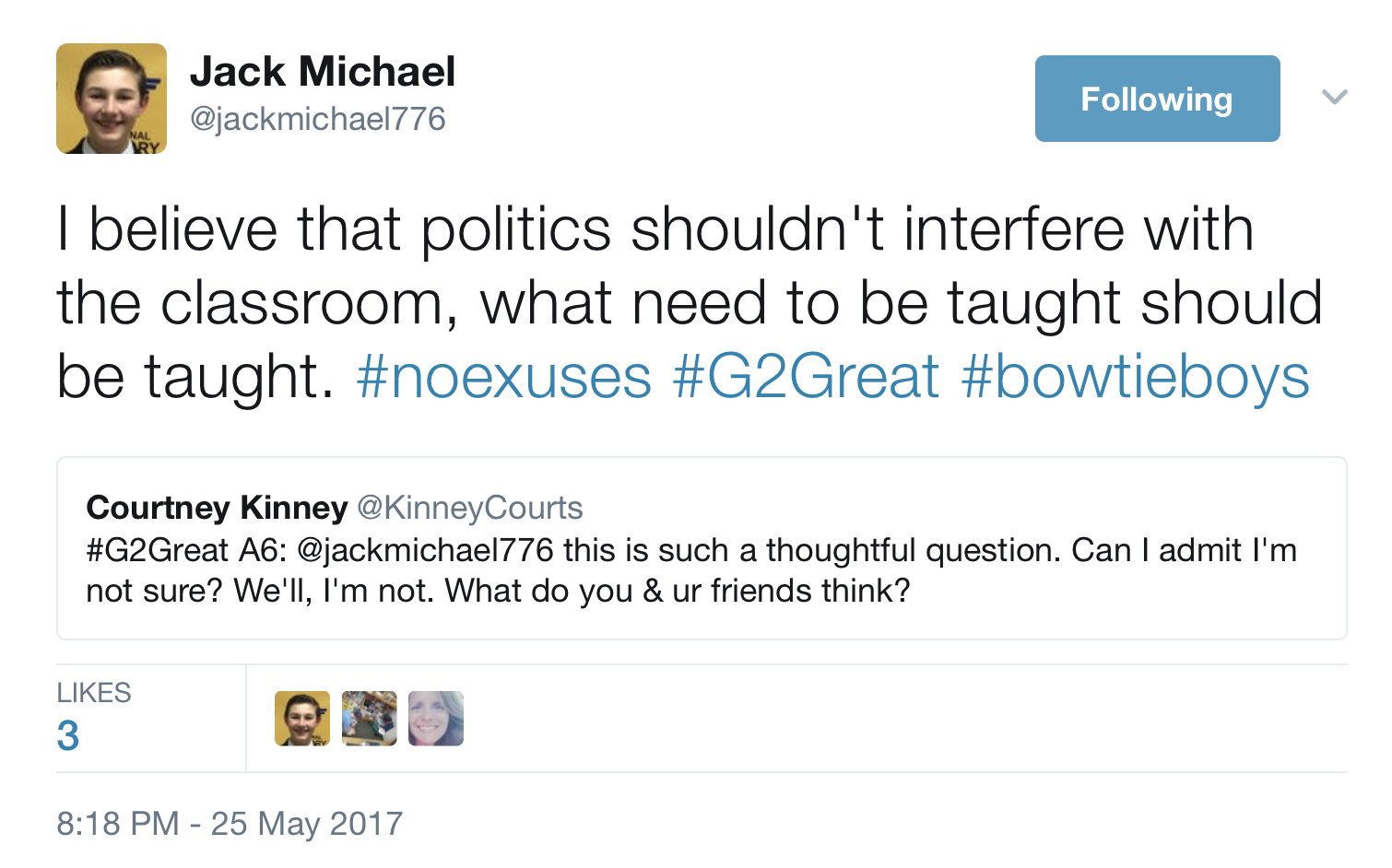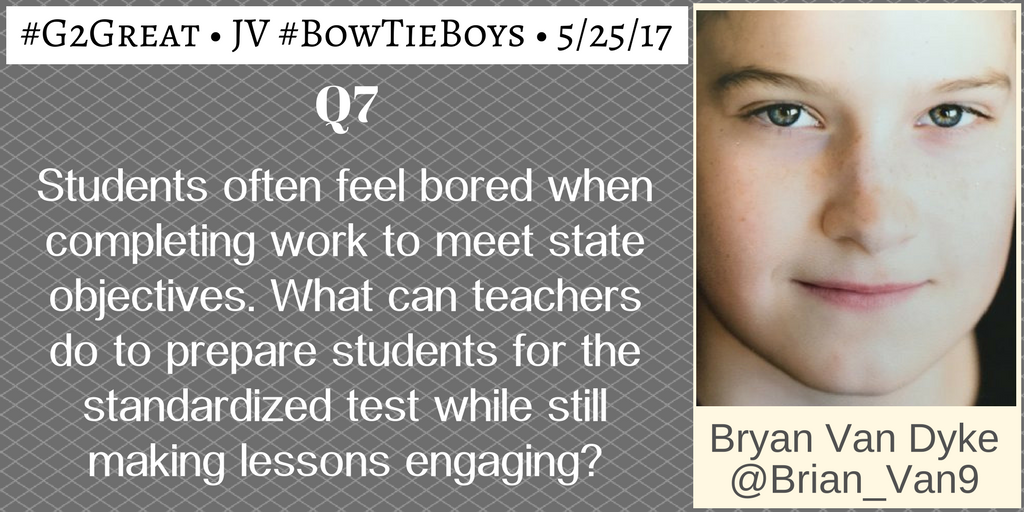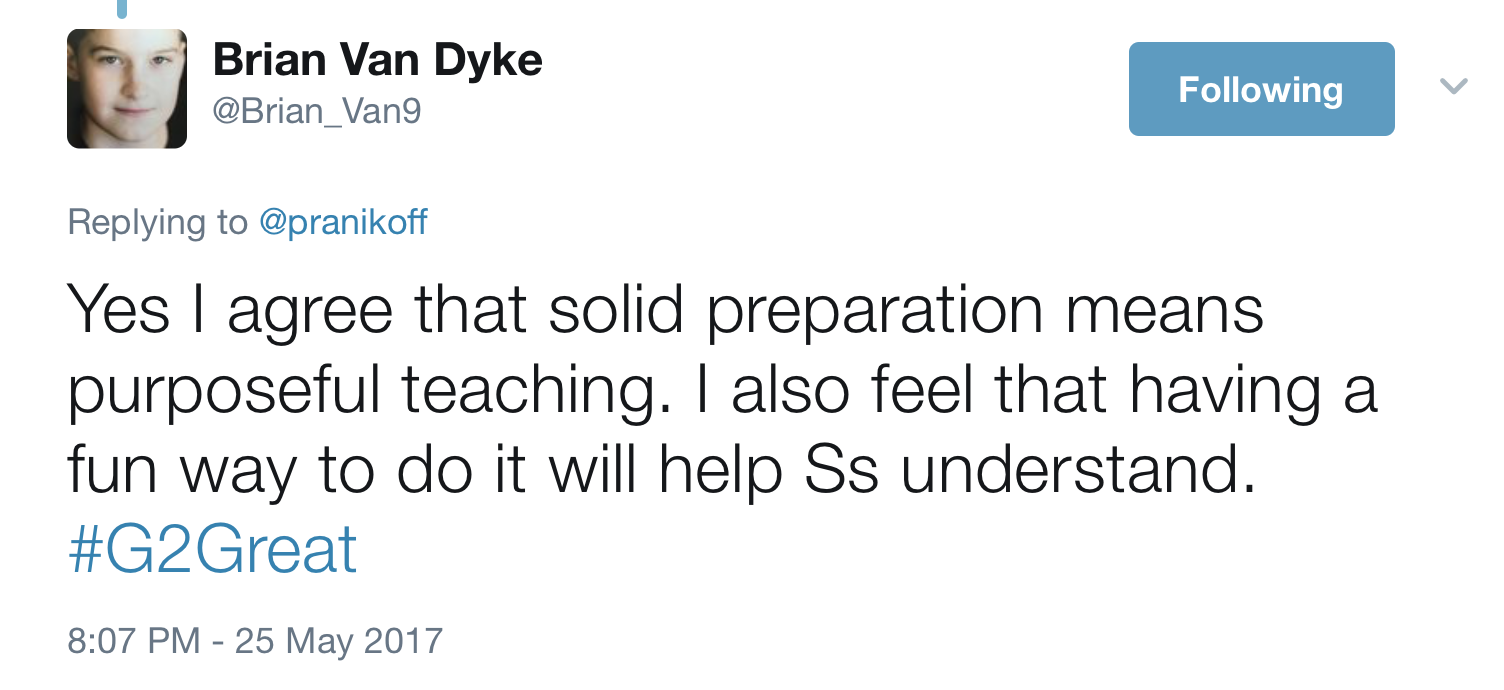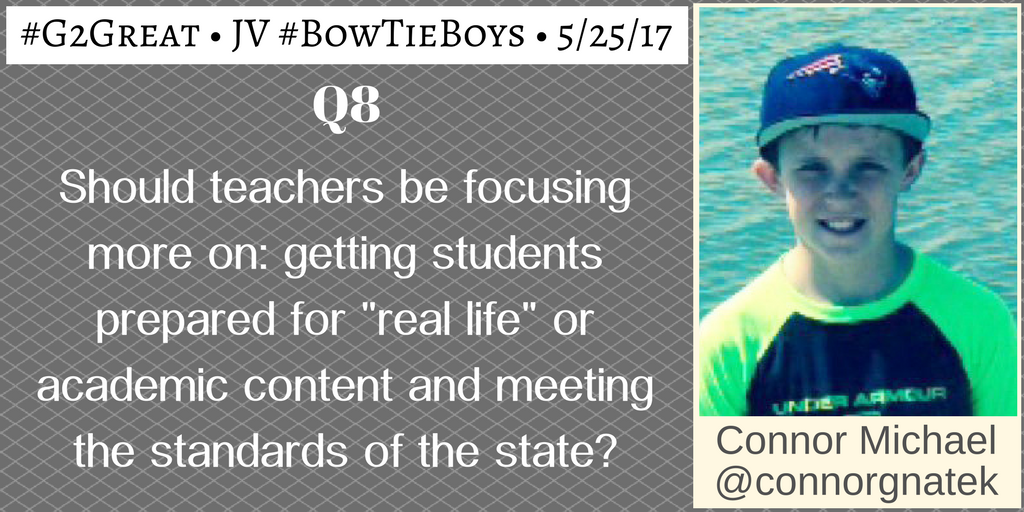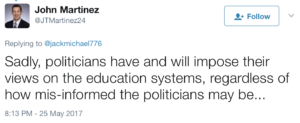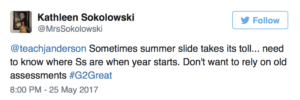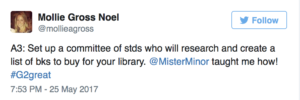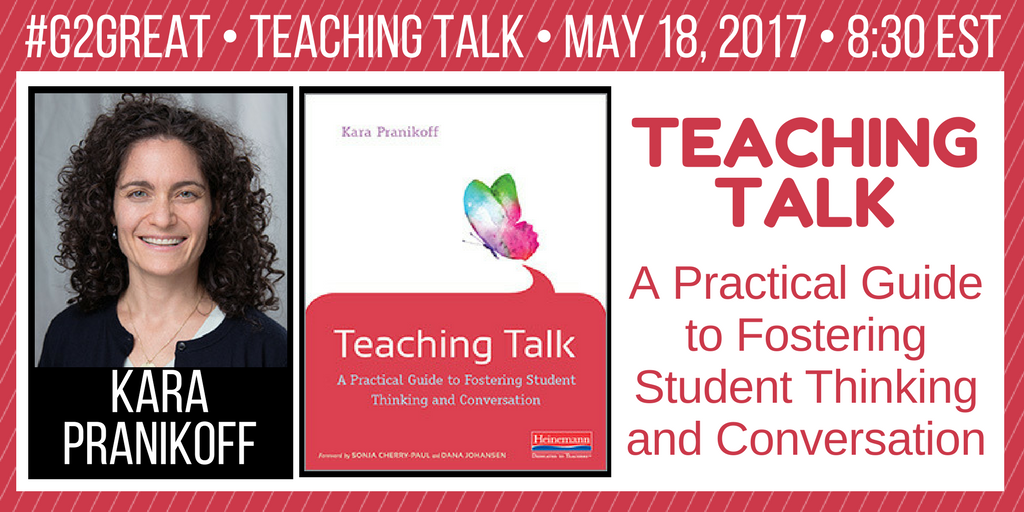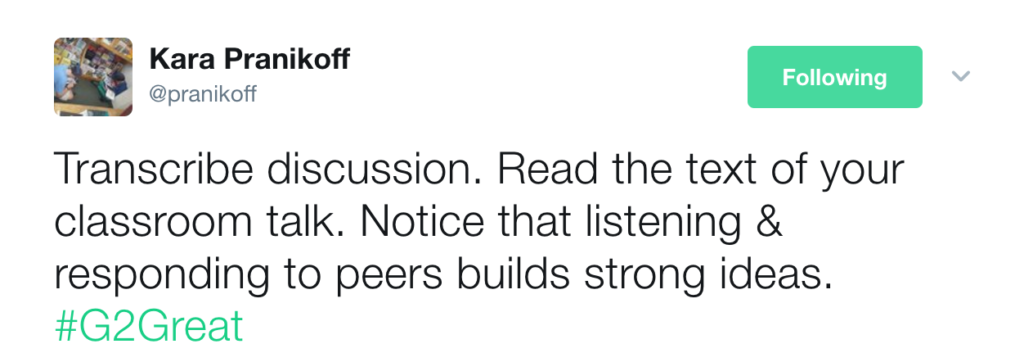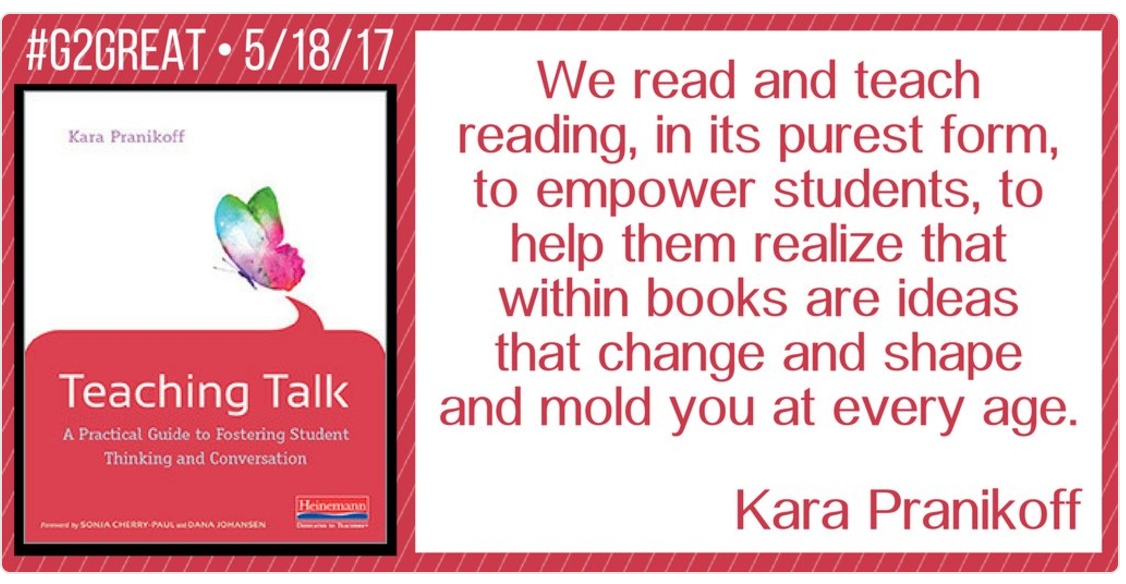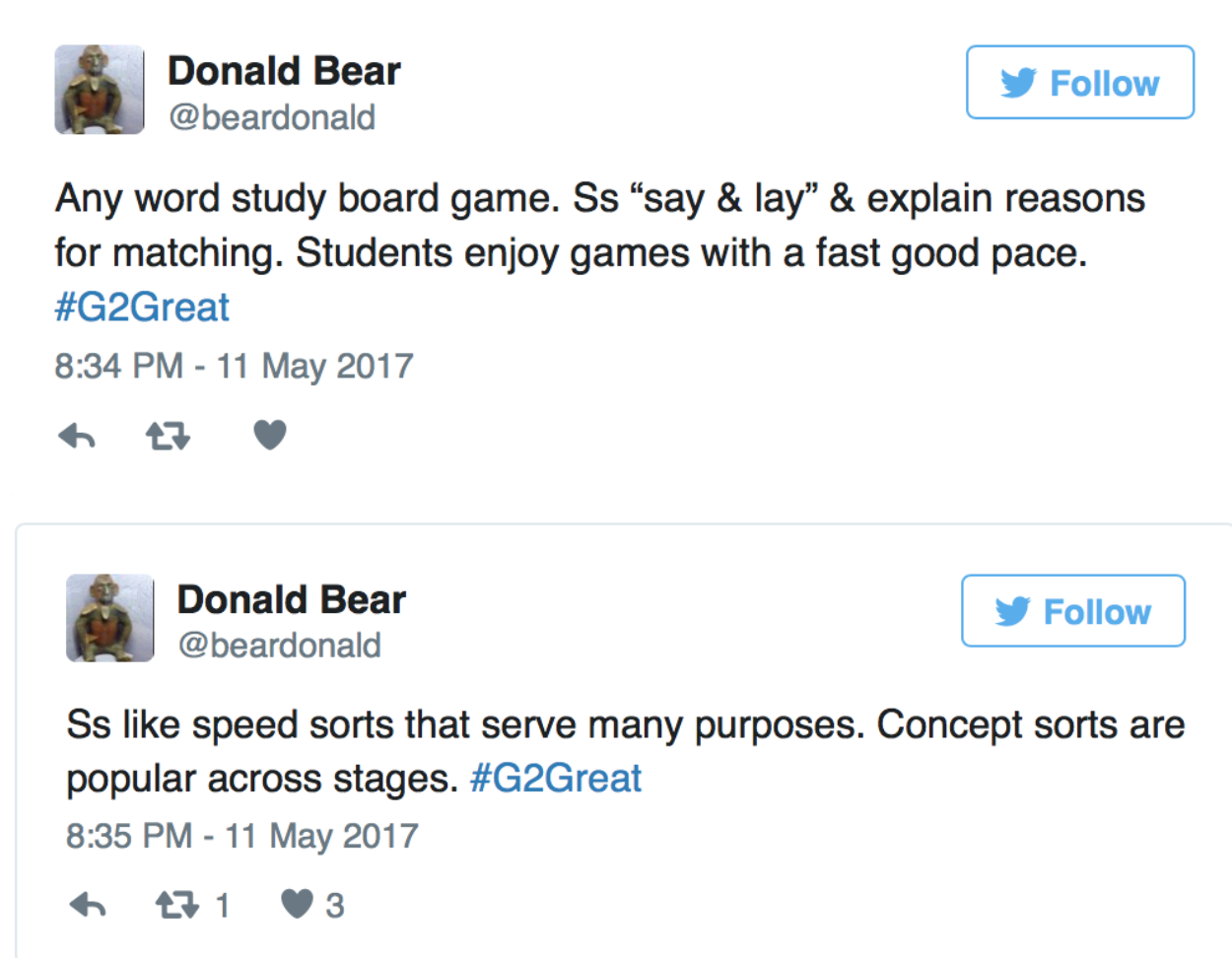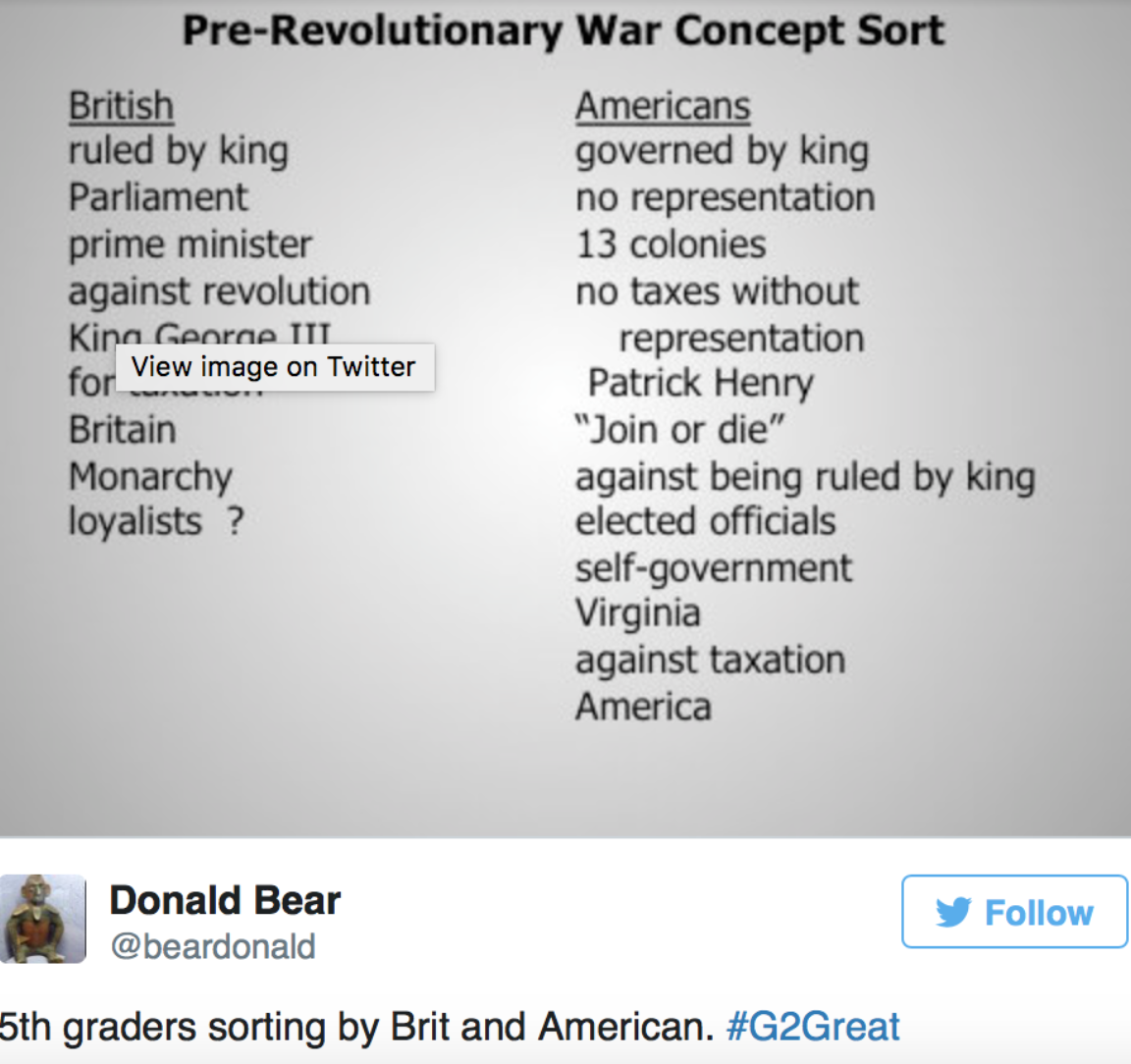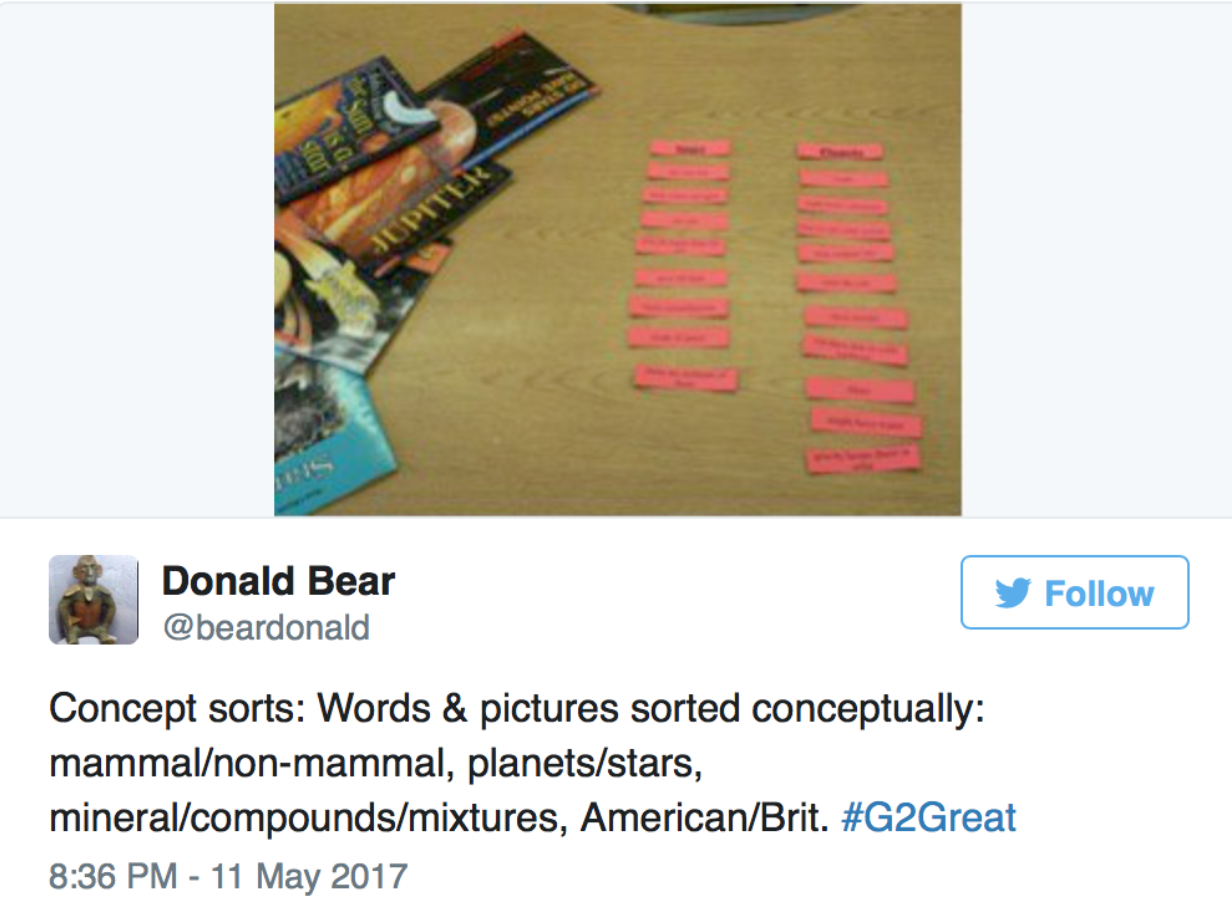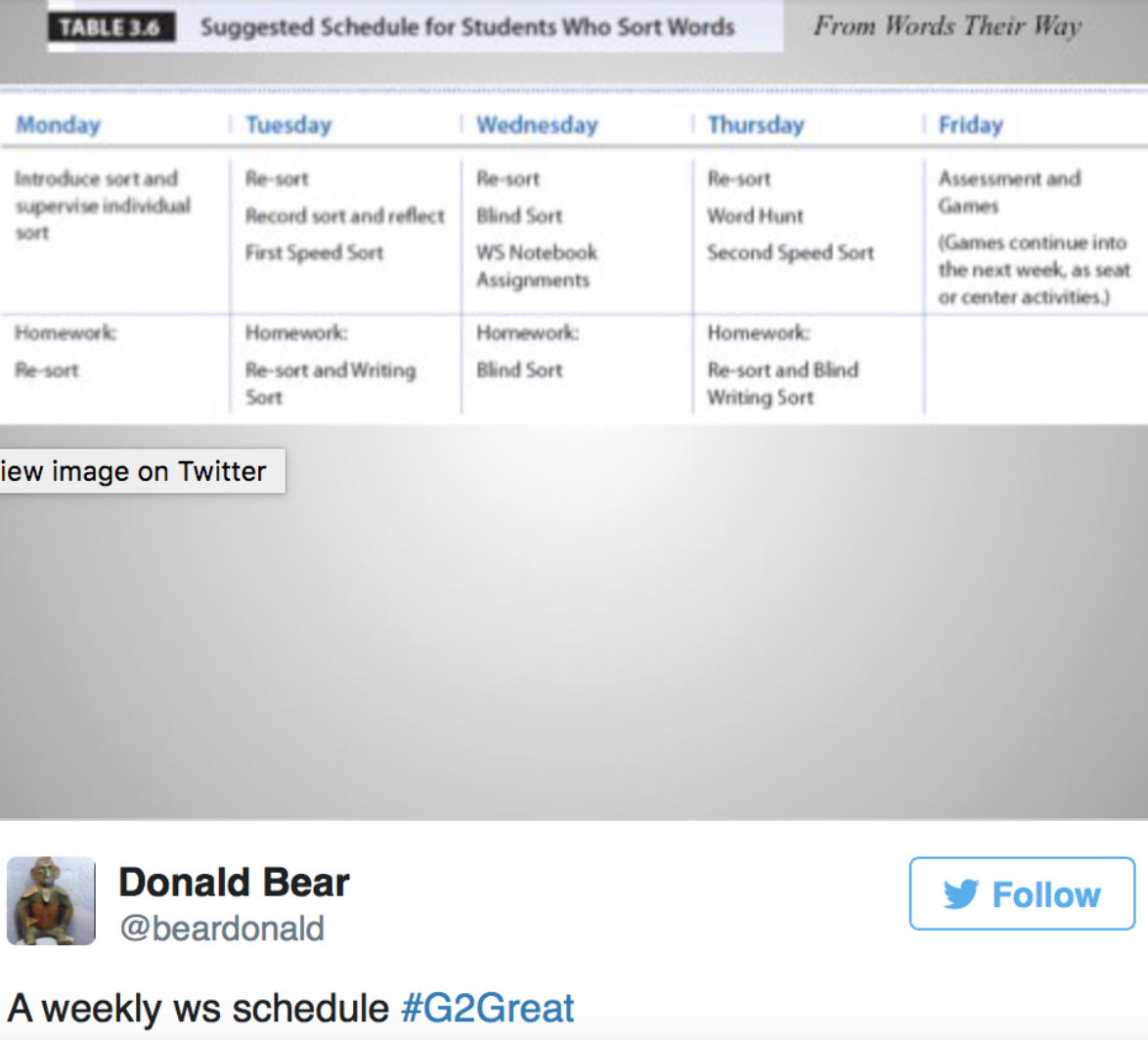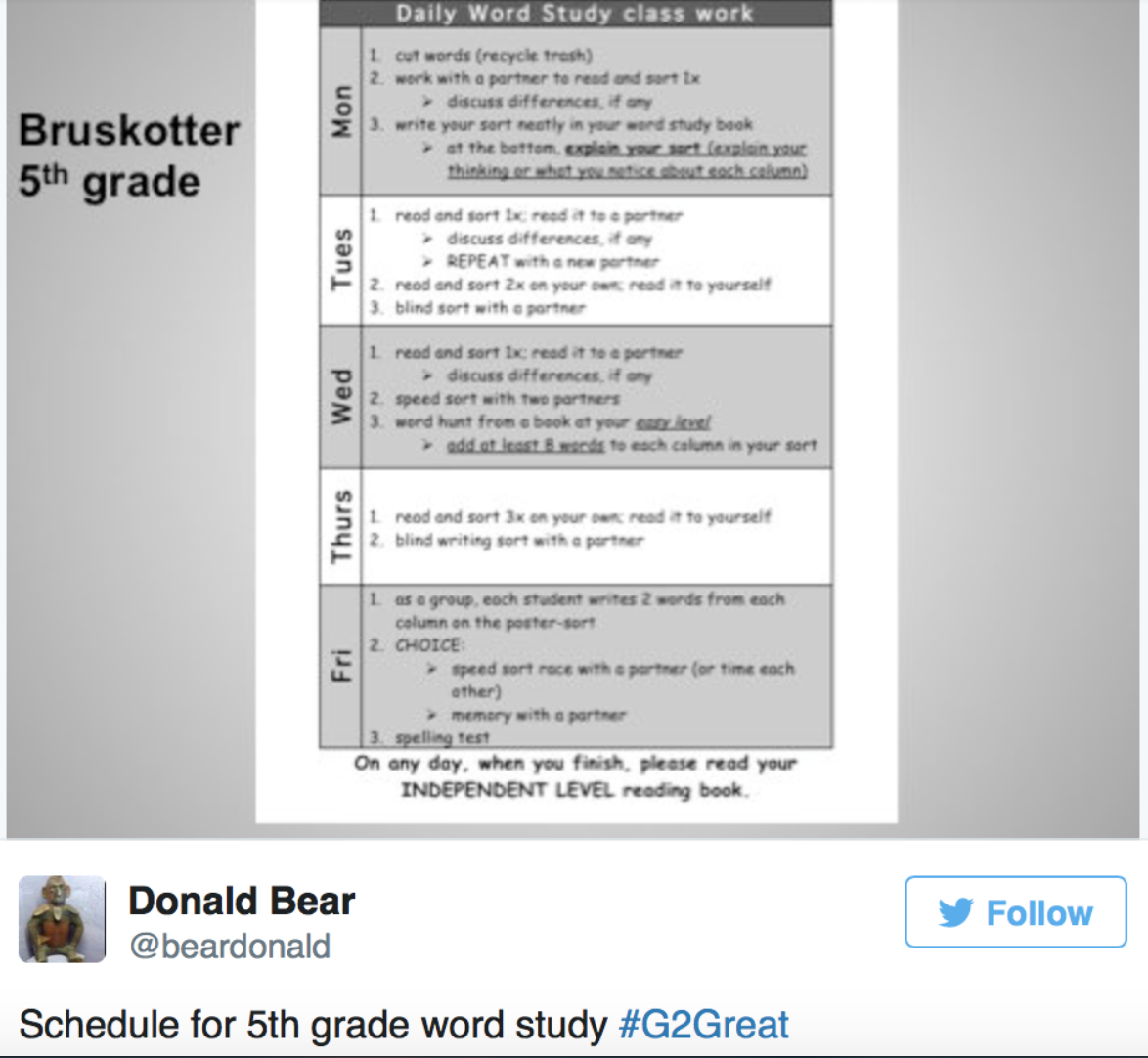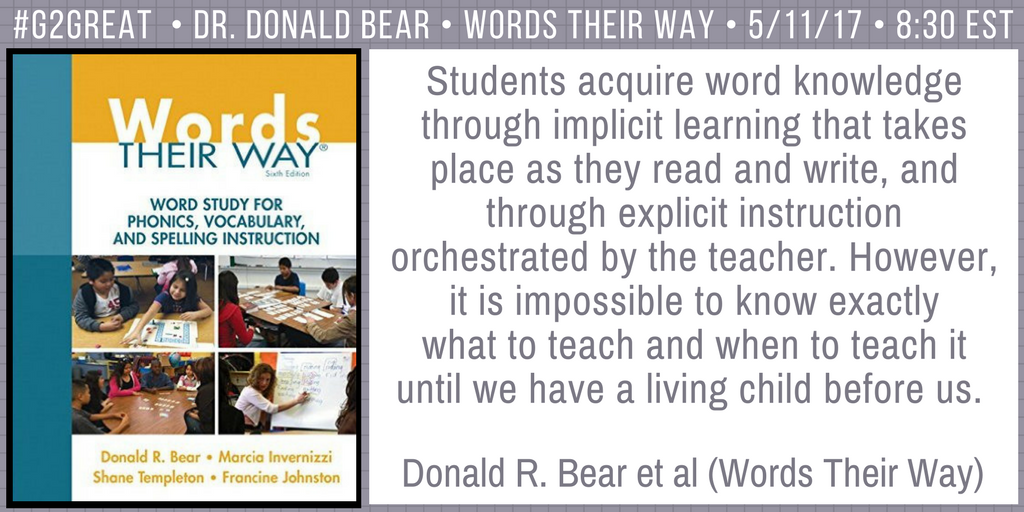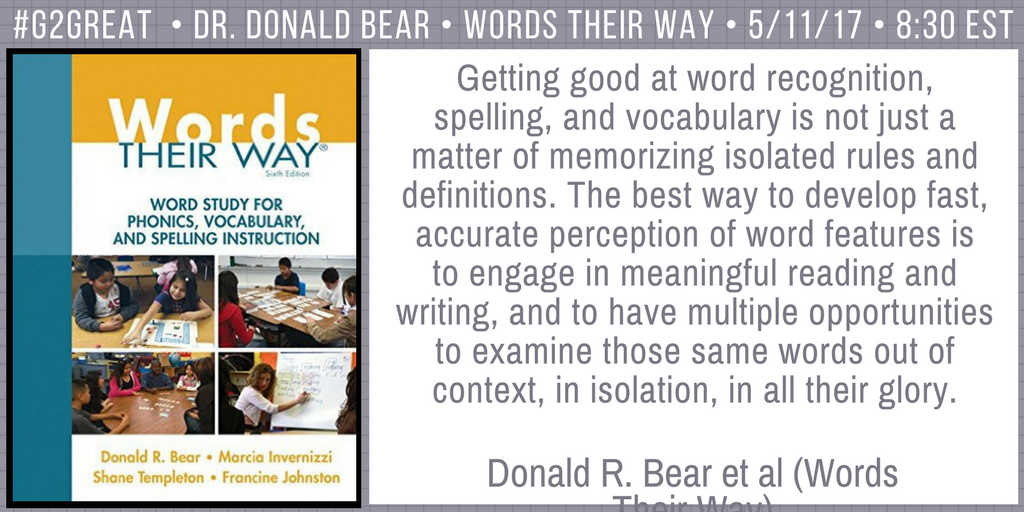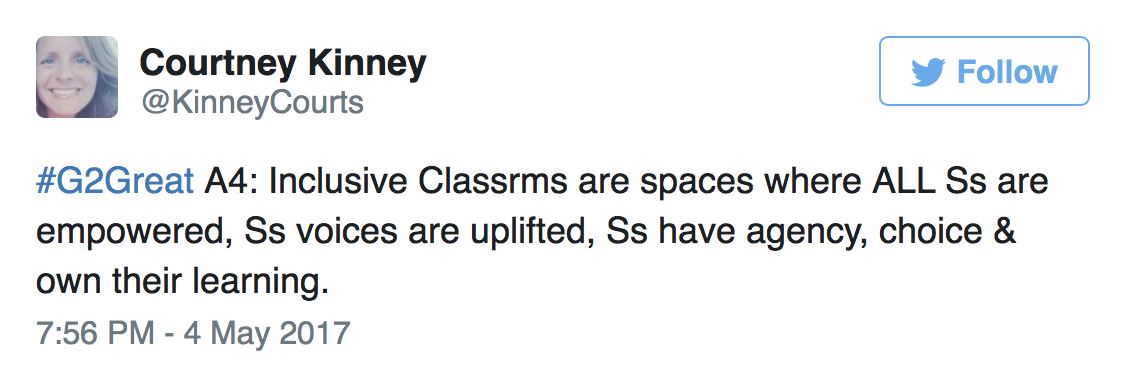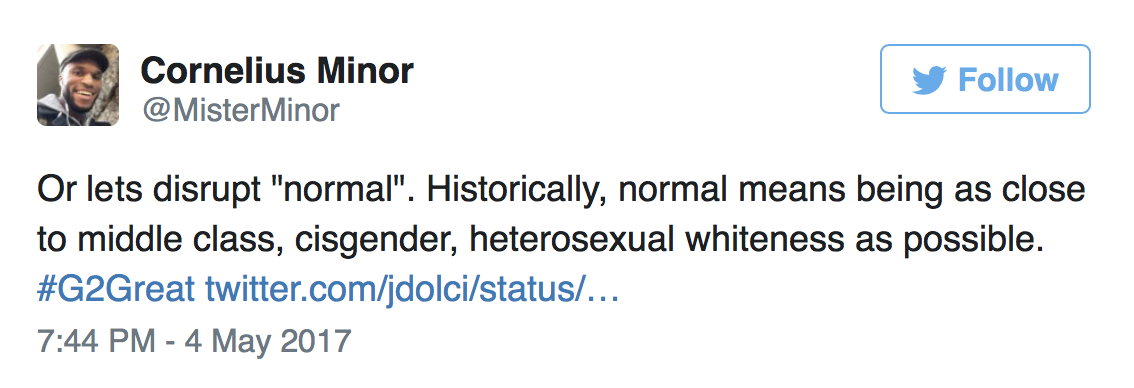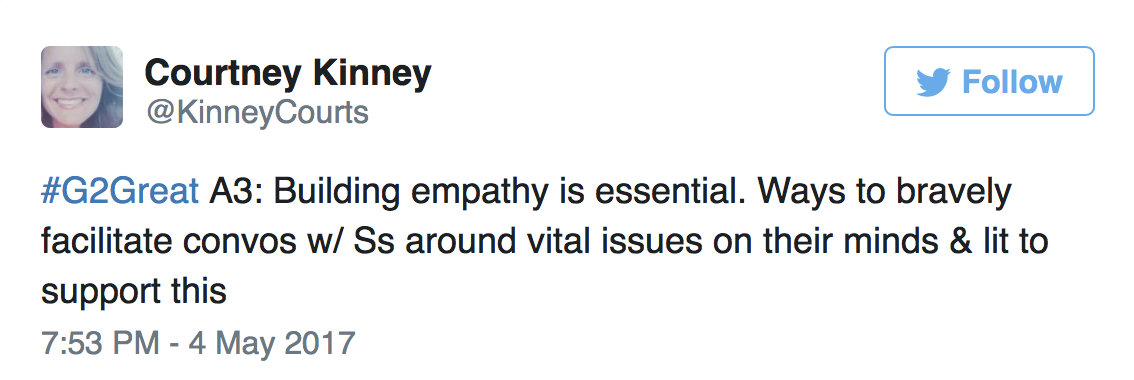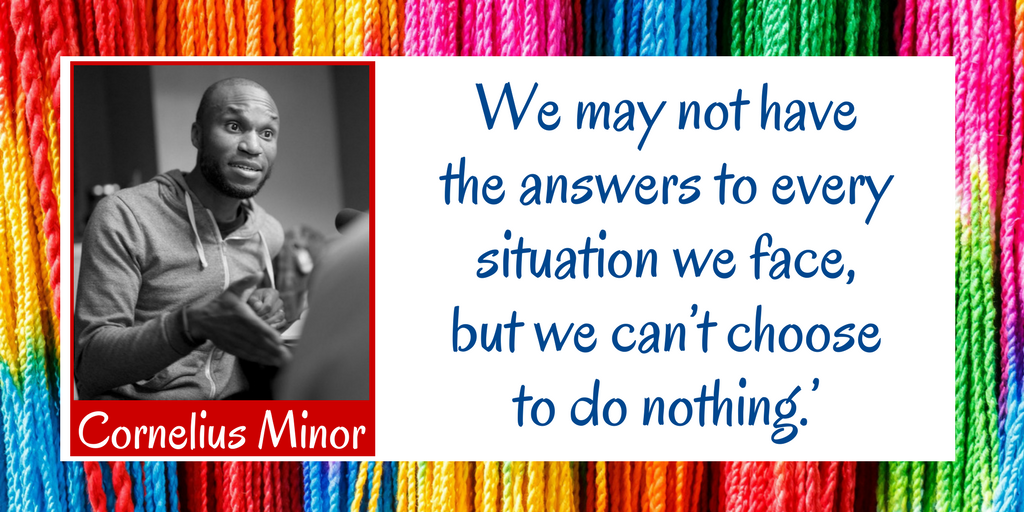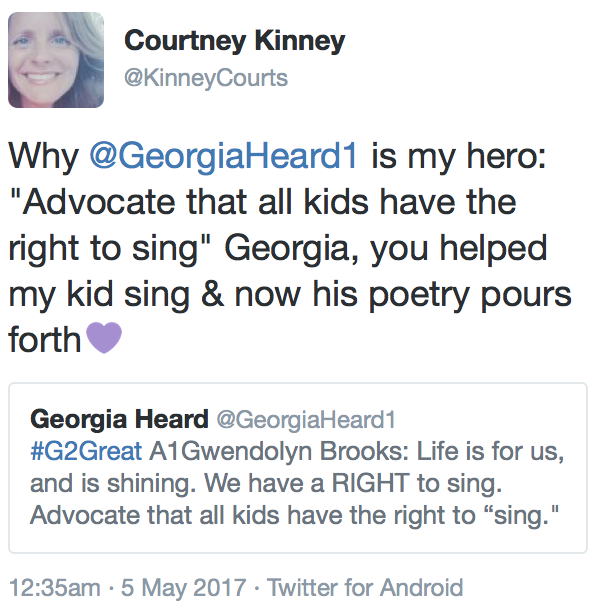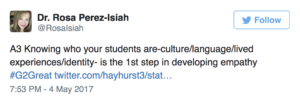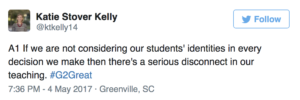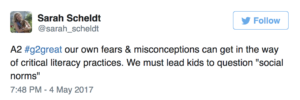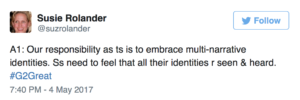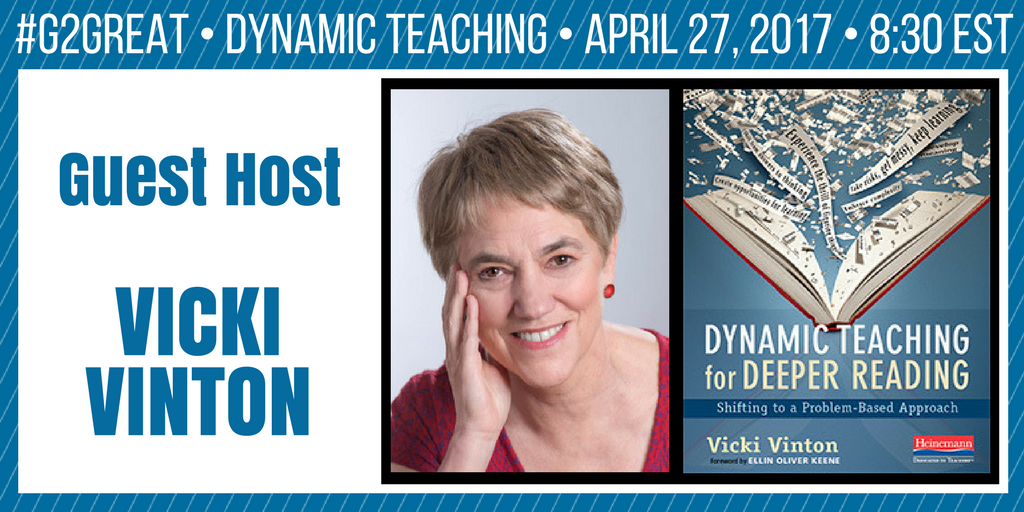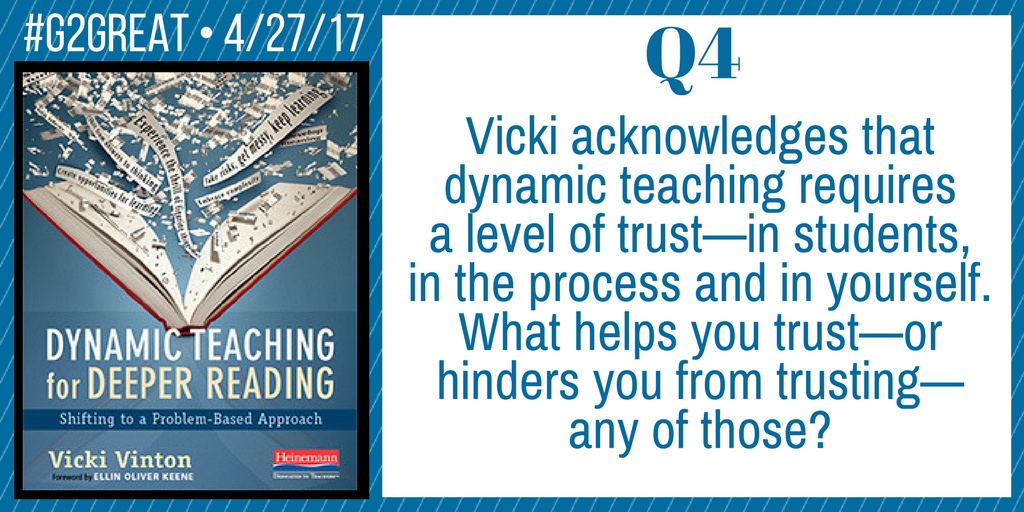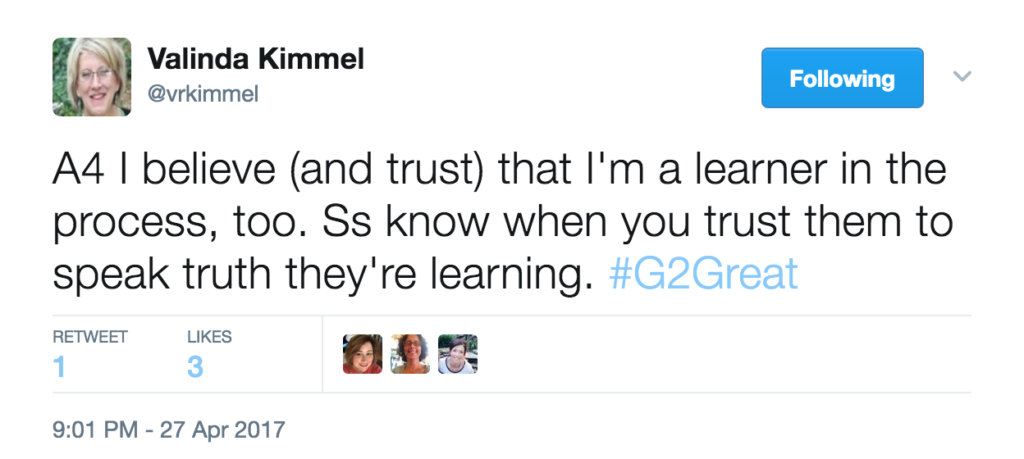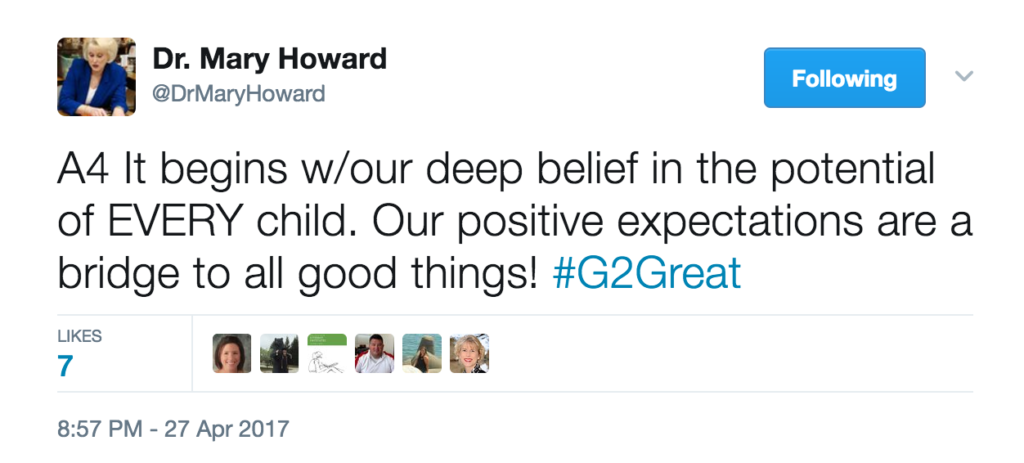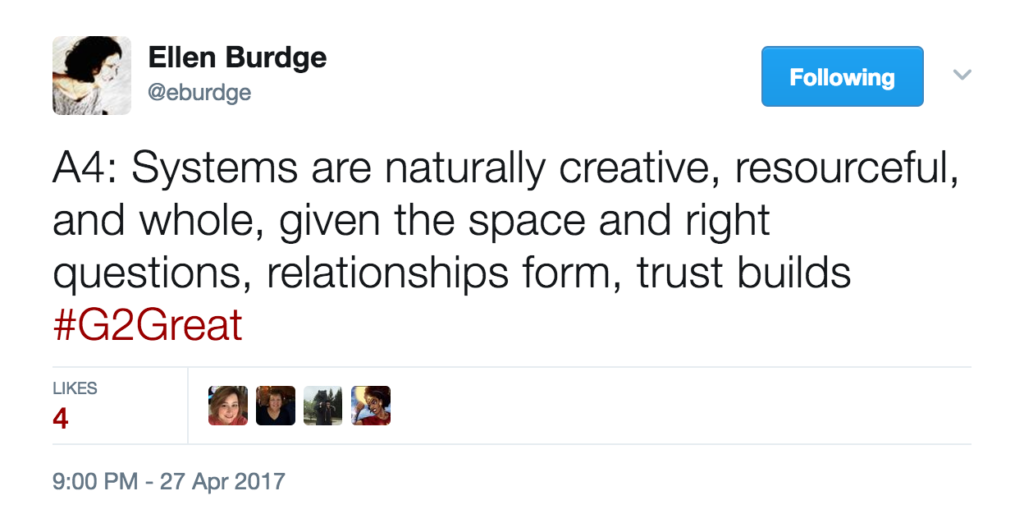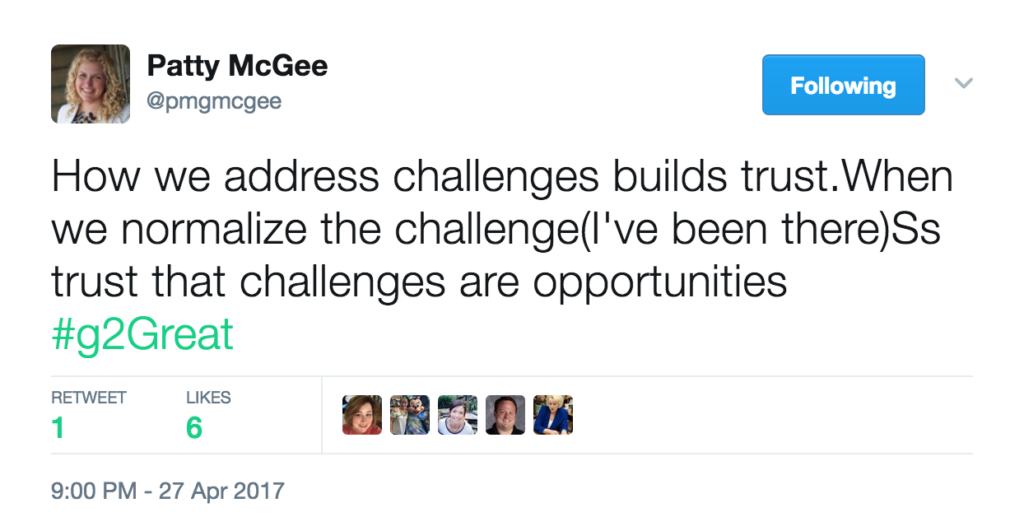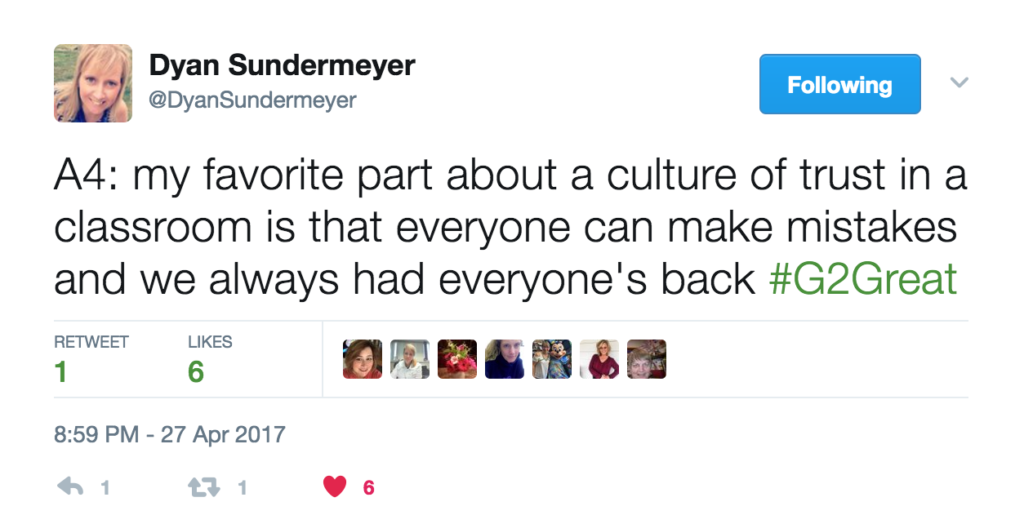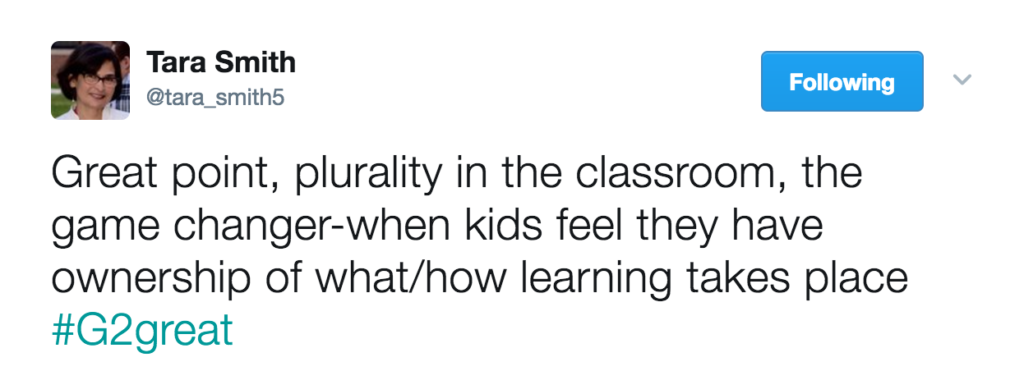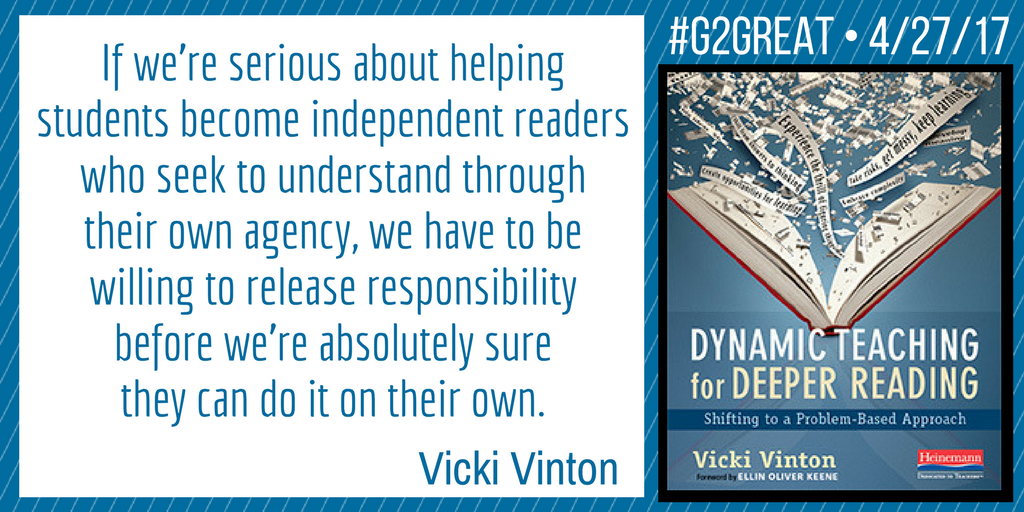On May 25, 2017 our #G2Great family enthusiastically welcomed old friends as #BowTieBoys became our teachers in a second round of Exploring Instruction through Our Students’ Eyes. The varsity #BowTieBoys were our guests March 16, 2017 (#G2Great blog) but this week we welcomed eight amazing Junior Varsity #BowTieBoys and high school English teacher Jason Augustowski – and our eyes were opened anew.
These remarkable seventh to ninth grade students happily took the #G2Great reigns, crafting and sharing their own questions based on their passion and research about teaching and learning (yes, you read that right). Their inspired questions brought our instructional lens into clearer focus, a lens sharpened by viewing teaching through the wise eyes of students. Before the #G2Great clock struck 8:30, it was clear that our teachers were as excited as we were. Jason illustrated why this student-teacher dialogue is so important and Twitter seemed to agree as #G2Great trended early in the chat.
And so in honor of our INCREDIBLE EIGHT, I’ll spotlight each question posed by our thought leaders with their words followed by my reflection on their message and themes that moved across questions. I am willing to bet that every teacher who participated in this experience walked away richer because we saw our teaching reflected in the eyes of eight amazing young men.
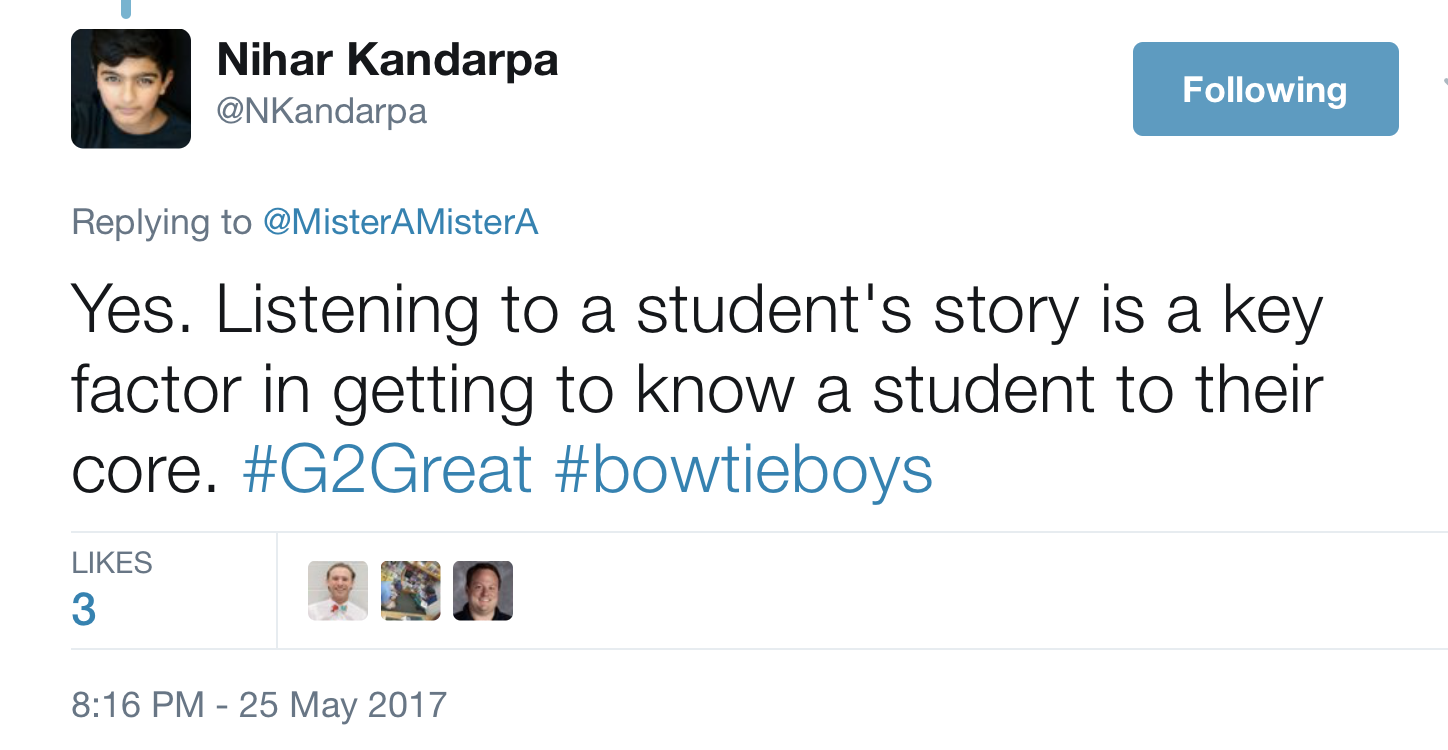
 My Takeaway Message from Nihar
My Takeaway Message from Nihar
Every teacher desires a classroom where student engagement is at the highest level. Nihar’s words drew our attention to an essential contributing factor for maximizing engagement. Engaged learning does not happen by chance. It reflects the dedicated day-to-day efforts of teachers willing to take time to know the stories each student brings to the learning experience. Our belief in their stories and sharing our own opens the door for a two-way venture into respectful relationships that extend beyond our four walls.
My Takeaway Message from Christian
Christian’s question about the role of technology is on the mind of every teacher as this role has escalated across our personal and professional lives. Christian acknowledged the power of WHY, emphasizing the impact of technology with purpose rather than simply for the sake of using it. His common sense balanced view of technology used with intention and purpose truly has the potential to elevate technology as the ‘icing on the cake’ of learning.
My Takeaway Message from Parker
Parker’s question also reflected technology but was approached from a different stance. From his first tweet to the last, Parker’s deep love of books was so evident. His virtual celebration of holding a ‘real book’ in his hands inspired us all and led to tweets about the smell and feel of books as we entered a shared literary love fest. Parker celebrated the efforts of teachers as they celebrate books to promote the very book love Parker lives and breathes every day… and we were all smitten by his joy.
My Takeaway Message from Bentley
We can all relate to Bentley’s concern for an obsession with ‘testing students to death.’ Once again, the word purposeful surfaced in our discussion and the dialogue quickly turned to assessment that has the potential to inform our practices. Bentley’s focus on teaching students to think was an important point as he helped us focus on assessment that allows us to take a closer look at student thinking within the context of authentic learning experiences.

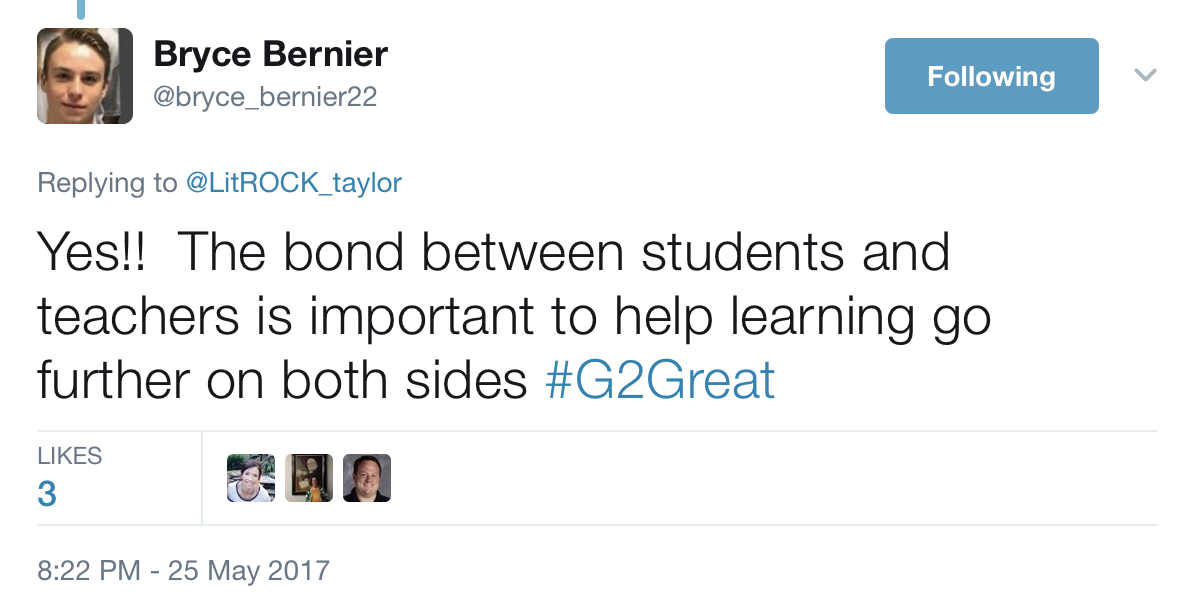 My Takeaway Message from Bryce
My Takeaway Message from Bryce
As a student athlete, Bryce opened our eyes to the impact homework can have on schedules that are already brimming to full. The discussion extended to many reasons this can negatively impact students. He posed a timely question considering the renewed concern about the value of homework while inviting student voices into the discussion added a new perspective. His words about the ‘bond between students and teachers’ reminds us that our willingness to see the homework issue from their side as well as ours is paramount as we view homework from every angle rather than just our own.
My Takeaway Message from Jack
Jack raised a unique question as teacher unions have come into question. Jack’s honest sense of curiosity reflected an open mind for both sides of the issue. In an age where politics and education have become a serious concern, we share his sentiment that politics should not ‘interfere’ with learning. We also acknowledge our responsibility to be accountable for our own teaching. Jack’s question is important since anything that has potential to interfere with teaching and learning should be heavy on our minds.
My Takeaway Message from Brian
As I looked back at tweets and questions, several themes emerged. Purpose was a major theme as Brian brought our attention to the role of ‘purposeful teaching’ and took us full circle back to the issue of engagement posed in question 1. He shared how his own sense of engagement increases through purposeful teaching leading to topics and projects that reflect interest. It would be difficult to argue motivation and engagement as inseparable features of engaged learning so this was a relevant message.

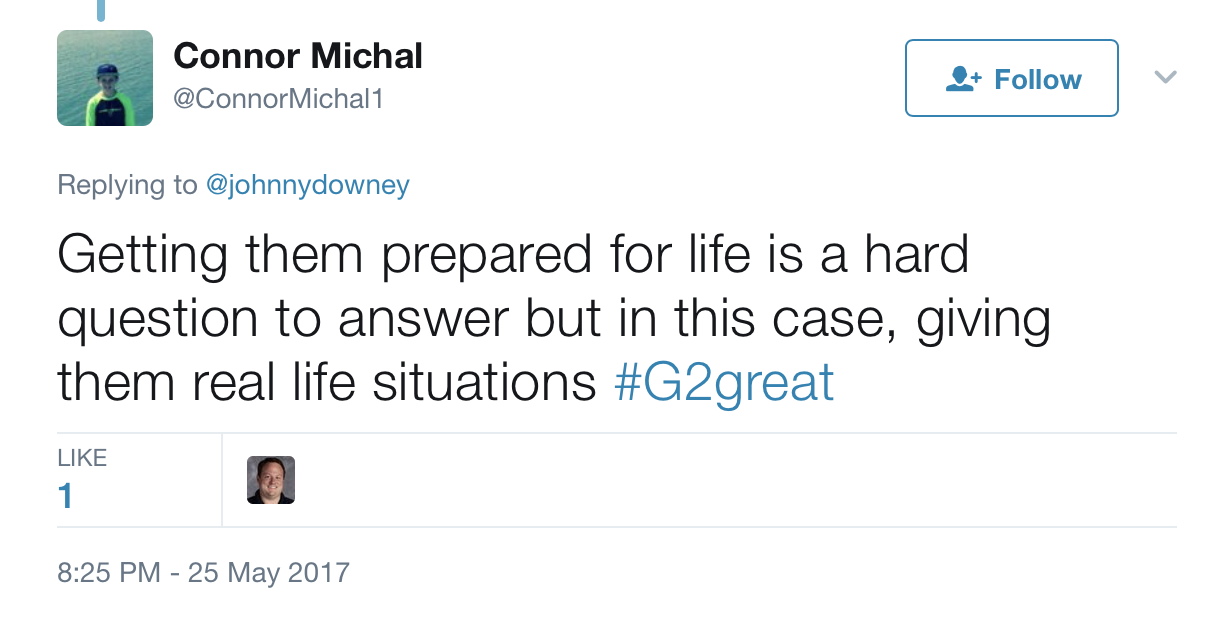 My Takeaway Message from Connor
My Takeaway Message from Connor
Connor’s question kept our sights on standards but shifted our attention on standards as a springboard to real life learning. He again emphasized that interest can significantly impact learning and revisited engagement in the discussion mix. His suggestion to offer learning experiences that bring students into real life situations highlights the value of celebrating the learning students will carry with them long after they leave our four walls. Moving from the ‘school’ thing to the ‘life’ thing is a goal that should always be at the forefront of our minds.
As I look back at our #G2Great – #BowTieBoys collaboration I am again inspired by the conversational atmosphere where questions flowed freely. Questions were not posed to seek ‘answers’ but to engage in an exploration of possibilities. Our shared curiosity about teaching and learning allowed each of us to comfortably move from teacher to learner as we stepped over any preconceived teaching-learning lines that could have divided us. By moving beyond our own perspectives we were able to embrace the perspectives of others and for one hour we became co-collaborators eager to understand the bigger picture.
We need to continue a collective merger of student-teacher voices. We need our students to understand teaching from our side and we need to understand learning from theirs. Bringing our two worlds together affords us an opportunity to broaden our view of both teaching and learning in dramatic and powerful ways.
So why do we keep our #G2Great door open to the magnificent #BowTieBoys? Well Jason Augustowski eloquently answered that question in his tweet. #G2Great invited these incredible young men and educators flocked to learn from them based on our commitment to teaching and learning. Thank you #BowTieBoys for helping #G2Great educators bring Longfellow’s words to life!
More inspired tweets from our #G2Great educators
Follow JV #BowTieBoys
Parker Anderson: (Gr. 8) @GnatekParker
Bryce Bernier (Gr. 9) @bryce_bernier22
BLOG: http://brycebernierbtb.blogspot.com
Bentley Chen (Gr. 9) @benjustchen18
BLOG: http://bentleychenbtb.blogspot.com
Nihar Kandarpa (Gr. 7) @NKandarpa
BLOG: http://niharkandarpabtb.blogspot.com
Jack Michael (Gr 7) @jackmichael776
BLOG: http://bowtieboyjack.blogspot.com/?m=1
Christian Sporre (Gr. 9) @CSporre
BLOG: http://christiansporrebtb.blogspot.com
Brian Van Dyke (Gr. 7) @Brian_Van9
BLOG: http://brianvandykebtb.blogspot.com
Connor Michael (Gr 7) @connorgnatek
